From Idea to Courtroom: Actions to Produce Effective and Convincing Trial Presentations
From Idea to Courtroom: Actions to Produce Effective and Convincing Trial Presentations
Blog Article
Browsing the Intricacies of Test Presentations: Tips for Seamless Shipment and Engaging Disagreements
In the world of legal procedures, the art of trial discussion stands as a vital component of success. The complexities integral in test discussions need a delicate equilibrium of skill, ability, and technique.

Comprehending Trial Objectives
To efficiently navigate a trial, it is crucial to have a clear understanding of the goals that require to be attained. Prior to entering the court, lawful teams should specify their goals and desired results. These purposes function as directing concepts throughout the trial, shaping approaches and influencing decision-making procedures.
Comprehending test purposes includes a detailed evaluation of the situation, legal precedents, and the customer's benefits. Trial Presentations. It requires a thorough exam of the truths, identifying crucial problems, and preparing for possible obstacles. By establishing specific and quantifiable objectives, attorneys can tailor their presentations and debates to straighten with the wanted outcomes
Furthermore, a clear grasp of test objectives makes it possible for legal teams to focus on proof, witnesses, and legal debates effectively. It permits the development of a coherent narrative that reverberates with the discretionary, enhancing the general case discussion.

Organizing Proof Efficiently
Having a clear understanding of test objectives lays the structure for organizing proof efficiently in lawful process. By straightening the discussion of proof with the desired outcomes of the trial, lawful teams can reinforce their arguments and enhance their persuasiveness.
An additional trick element in organizing evidence efficiently is establishing a sensible flow. Providing evidence in a consecutive and coherent way can aid construct a compelling story that sustains the lawful debates being made. Furthermore, utilizing visual aids such as charts, graphs, or timelines can even more boost the company of evidence and assist in clearing up complicated connections or sequences of events.
In addition, making sure that all evidence provided is admissible and pertinent to the case is crucial. Inadmissible or pointless proof can diminish the toughness of the debate and potentially hurt the reputation of the providing celebration. A thorough testimonial and selection process ought to be taken on to include only the most lawfully audio and impactful evidence in the test discussion.
Crafting Influential Narratives
Crafting engaging stories plays a critical role in presenting persuasive disagreements during legal process. A well-crafted story has the power to mesmerize the audience, stimulate emotions, and eventually sway the decision in favor of the offering event. When creating a narrative for a test discussion, it is necessary to establish a clear story that highlights bottom lines and connects them in a coherent fashion. Begin by laying out the facts of the case in a compelling way, guaranteeing that the sequence of events is simple to comply with. Introduce characters efficiently, supplying history info that aids the audience understand their motivations and actions. Additionally, incorporating vibrant descriptions and interesting language can bring the story to life, making it more unforgettable for the court and court. By weaving with each other proof, testimony, and lawful disagreements into a cohesive and convincing story, lawful experts can successfully promote for their customers and enhance the possibility of a desirable result in the court room.
Understanding Visual Aids
Effective usage of aesthetic aids is crucial to enhancing the effect and clearness of trial discussions. Visual aids, when made use of purposefully, have the power to simplify complicated information, strengthen essential factors, and leave a long-term perception on the discretionary. To understand visual help in trial discussions, it is important to make certain that they are clear, succinct, and relevant to the debates being made.
When including aesthetic aids, such as charts, charts, timelines, or photos, right into a test discussion, it is necessary to maintain them visually appealing yet professional. The visuals should complement the verbal disagreements, supplying a graph of the details being reviewed without frustrating the target market with unnecessary details.
Moreover, practicing with the aesthetic help beforehand is crucial to guarantee a smooth distribution during the test. Acquainting oneself with the web content, shifts, and timings of each visual help can help maintain the circulation of the presentation and avoid technological glitches that may emerge.
Delivering Impactful Closing Disagreements
An engaging closing disagreement serves as the culmination of a trial presentation, enveloping the core story and encouraging the judge and jury towards a positive choice. Begin by laying out the primary arguments that sustain your customer's setting, emphasizing why the evidence presented throughout the trial sustains your story.
In addition, integrating psychological appeal can further enhance your closing disagreement. Eventually, a well-crafted closing debate should leave a long-term impression, engaging the court and jury to rule in your client's support.
Conclusion
To conclude, understanding test discussions involves comprehending goals, arranging proof, crafting stories, utilizing aesthetic help, and delivering impactful closing arguments. By implementing these approaches effectively, attorneys can offer their instance perfectly and make compelling debates in the courtroom. It is vital to browse the intricacies of trial presentations with precision and ability to attain success in Read Full Report lawful process.
By aligning the presentation of evidence with the desired end results of the test, legal groups can reinforce their debates and improve their persuasiveness (Trial Presentations). To master aesthetic help in trial discussions, it is crucial to make sure that they are clear, concise, and appropriate to the disagreements being More Bonuses made
An engaging closing disagreement offers as the conclusion of a trial discussion, encapsulating the core story and persuading the judge and jury towards a beneficial choice. Begin by describing the major debates that sustain your client's placement, stressing why the evidence presented throughout the test sustains your story.In final thought, mastering trial presentations involves comprehending goals, these details organizing proof, crafting narratives, making use of aesthetic help, and supplying impactful closing arguments.
Report this page